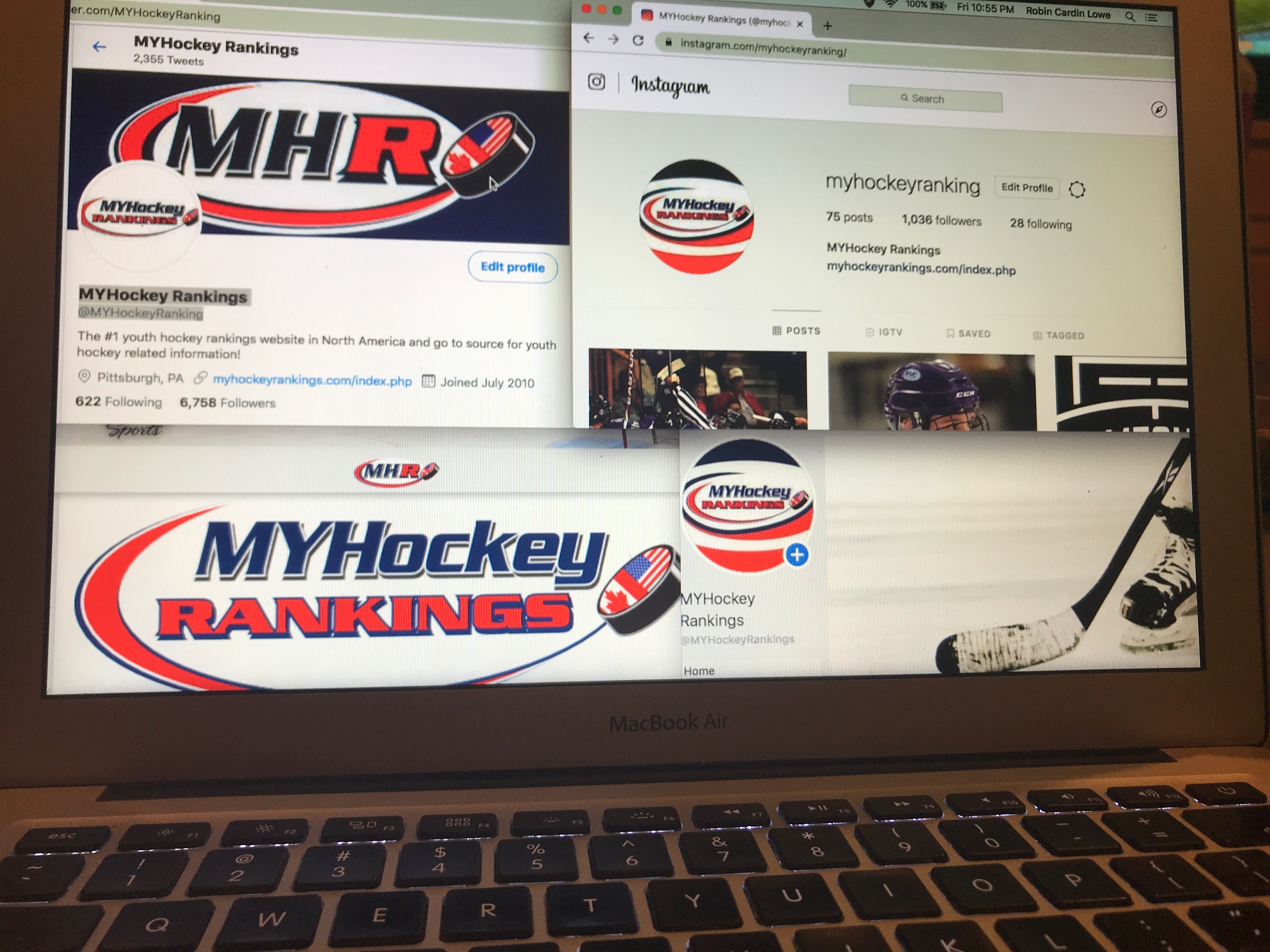
Embrace Technology to Help Your Club Grow
By Scott Lowe
MYHockeyRankings.com
Times have changed, and for better or worse, technological advances have made it easier than ever to communicate with the masses.
It doesn’t matter whether you’re an A-list celebrity, a millionaire athlete or a parent managing your kid’s hockey team in Any City, USA or Canada. With a computer, tablet or phone and a few calculated button clicks you can be on center stage for hundreds, thousands or even millions of people to view or follow.
Technology, of course, can be a double-edged sword. Being able to reach the masses with such ease also means that if you aren’t careful you can do more harm than good to your brand or personal image if the wrong Tweet, photo or video goes viral. And, first with the Internet and later with the various social media platforms that have become popular, an insatiable thirst has been created among the general population for instant access to information and breaking news as well as the desire to be able to find out everything about anything in within seconds using a hand-held device.
“Social media has created a historical shift from the historically powerful to the historically powerless,” said Facebook Chief Operating Officer Sheryl Sandberg. “Now everyone has a voice.”
Not only does everyone have a voice, but everyone has a powerful way to market and promote any idea, product or affiliation right at their fingertips. This is true in the youth hockey world, too, and failure by clubs to take advantage of this opportunity can have a drastic negative impact on the public perception of a club and do a disservice to the families who pay thousands of dollars to be part of that organization.
I write this article with the understanding that most – but not all – youth hockey clubs across North America rely on volunteer parents who serve as team managers or board members to create and/or manage websites, to establish internal lines of communication and to provide such important functions as marketing and digital media management. These wonderful volunteers donate their time generously and usually are performing a balancing act that includes full-time jobs, responsibilities at home and maybe even coaching or other activities within the organization.
There’s no doubt that it’s a lot to ask of people when you consider everything that most families have going on these days, and volunteers often have to perform thankless tasks in which they receive far more complaints and negative feedback than compliments.
Still, for youth hockey clubs, it is imperative to their well-being on and off the ice to present a strong and professional brand image, communicate internally and with the public at-large efficiently and effectively and be an accurate source of information to those inside and outside the organization. Failure to do so can be detrimental to the club’s image and bottom line – and ultimately its performance on the ice as well.
A sharp, informative and regularly updated website is imperative as any club attempts to establish its brand and public image. The bad news is that, while easier than in the past, creating a fully functional website is still incredibly tedious and time consuming. Then, once it’s created, keeping the site current with all the information that is expected such as news and announcements, the club’s mission and values, rosters, schedules, records, etc. is a tremendous undertaking.
The good news is that there are several companies servicing the youth sports community that will build a professional-looking site that requires little or no programming knowledge and is easy for even a technology novice to update. Because these companies cater speficially to the youth sports industry, they have encountered and solved nearly every conceivable issue, concern and obstacle that has arisen over time.
And there is more good news. Every club has a group of parents with a vested interest in the program as well as their child’s experience and future in the sport. So once the site is developed and operational, it shouldn’t be hard to find enough people to share the workload so that it doesn’t become overwhelming for any one person and to help keep the site fresh and current, which is of utmost importance.
Just having a sharp-looking site is not enough. It has to contain useful and updated information.
Remember, everyone’s first instinct these days when they are looking for information is to “Google” something. Yes, “Google” is a recognized word these days, most often used as a verb referring to an online search for information. Microsoft Word did not place a red squiggly under my use of Google as a verb in that previous sentence, which is just more evidence of its acceptance as a common usage among the general population in the 21st century (For what it’s worth, there also was no red squiggly under “squiggly”).
“If it isn’t on Google, it doesn’t exist,” Jimmy Wales, co-founder of Wikipedia, once said.
Remember the old adage “You never get a second chance to make a first impression?” For most youth sports organizations – well, really for pretty much any entity – thanks to Google, your website is going to provide that first impression to most people.
For the parents of a child who is interested in playing hockey, the ease of finding the information they are looking for on an organization’s website – along with the ability to learn more about the club’s coaches, goals, pricing, etc. – is going to play a large part as to whether they decide to ramp up their interest level from passive to active and truly consider enrolling their child in a particular program.
While the club website doesn’t have to be the most amazing, cutting edge, fancy, full of bell and whistles site in your area, it should be easy to navigate, appealing to the eye, inclusive of the basic information any parent would need and current.
The continued existence of any youth sports organization is dependent upon its ability to draw in new members and limit member attrition as much as possible. A professional and complete website can go a long way toward accomplishing both.
If a potential new member logs on and finds that the site is full of phone numbers or email addresses that don’t work, that the rosters and schedules haven’t been updated since 2017 and there is no listing of currently available programs or ways to register, what do you think the chances are that person will consider enrolling a child?
Likewise, if someone already is a member of the organization and can’t readily find information about tryouts, practices and games or communicate easily with coaches, team managers or board members, the odds of that player’s family becoming dissatisfied and moving to another club increase dramatically.
The basic essentials – contact information, important dates, schedules, directions, locations of games and practices, etc. – are necessary for a club to function efficiently. Touches such as updated results, game summaries and recaps, articles about players and teams and features such as players or plays of the week or coach spotlights can really seal the deal in terms of long-term club loyalty and attracting new members.
I’m old enough to remember the days of the weekly local newspaper. Being a multi-sport athlete I recall grabbing our town weekly paper and hoping that my goal, assist or home run would be mentioned on the sports page, praying that they spelled my name correctly and cursing the editor who determined that our team deserved four column inches instead of six – then wondering why my performance was what got cut out of the article.
Coverage of youth and high school sports once was considered a legitimate way to sell more newspapers to more people. And now that technology has given us the ability to post information almost immediately, the thirst to see our own or our children’s accomplishments reported – on the web, via social media or even through a video platform – seems to increase daily.
Using a club’s website, Facebook, Twitter or Instagram account to highlight a team’s and individual player’s successes simply adds to the experience of an organization’s families, in turn building loyalty. While social media use can become all-consuming and eat up a large portion of someone’s free time, when it comes to promoting teams, it doesn’t have to. Parents are at the games, they have their phones available and often are on them throughout the contests. How hard is it to send out an occasional in-game update or brief game summary at a game’s conclusion?
And don’t just post or talk about the wins.
Kids play hard and coaches work hard every time they take the ice, and a lot of good things happen even in a loss. Don’t be an organization that talks about only the victories and championships. Be consistent with the information you provide via the web and social media. Celebrate the small victories with the understanding that you might be helping a group of players on a team that is struggling remain excited about coming to the rink and give them something to strive for and keep them motivated.
Remember, one of the goals in effective utilization of technology is to help your club grow. There are many other families involved with other programs that might be having a bad experience. Perhaps they are dealing with internal club politics or looking for a club that is a better fit in terms of the opportunity to play more and improve.
Whatever the reason, if a club is consistently active on social media and has a great website that is updated regularly, there is a good chance that when someone who is disenchanted with their situation “Googles” that organization, they might be swayed to come on board in the future.
Social media also can be a great way to communicate internally, as the team account can be used to send out practice reminders, schedule changes, weather-related announcements and other team news more effectively and efficiently than by having a manger try to contact each person individually. Instead of being all-consuming, effective social media use might actually help free up time for a team manager or digital media volunteer.
In addition to helping draw new members to your organization and keep its current members happy and engaged, effective use of technology can serve another important purpose as your players get older and decide they want to continue playing beyond the youth and high school levels.
Higher-level coaches who are looking for players are going to “Google” (there’s that word again) a player’s name to find out more about him or her. The easier it is for a coach or scout to locate information about players, the better their chances become of being scouted in person, contacted about potential tryouts and ultimately advancing to higher levels beyond youth hockey.
On the flip side, nothing is more frustrating than looking for a player and not being able to find any information on an organization’s website. There is no doubt that some players lose opportunities primarily because their clubs don’t do a good job of promoting them. An organization's website and social media accounts are the easiest and most effective means to expose its players for those higher-level opportunities as they progress up the hockey developmental ladder.
As players move on to higher-level programs or to junior and college hockey from your club and you utilize technology to promote their achievements, what is happening?
You’re marketing the organization effectively and generating more interest in the club. And then we’re right back to where this discussion started, aren’t we?

